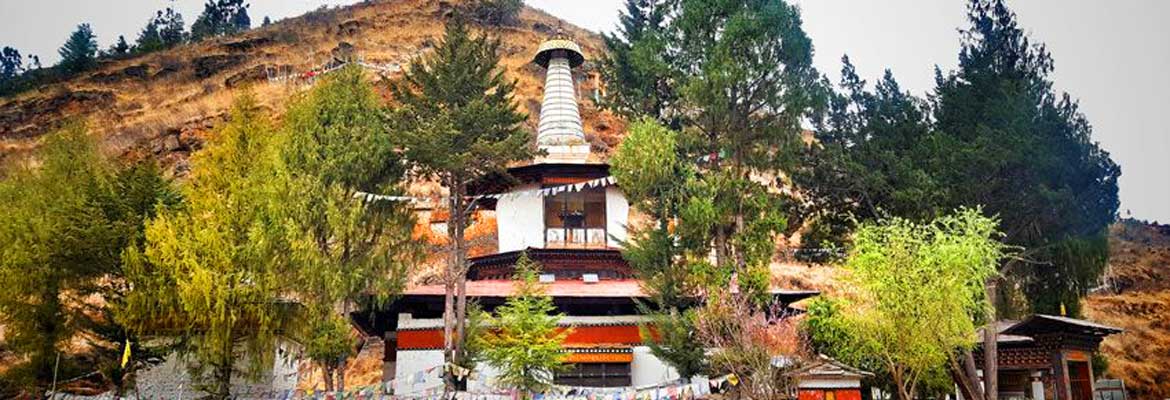
Dungtse Lhakhang
Paro - Thimphu - Punakha - Wangdue - Bumthang
Overview
Often referred as Jangtsa Dumtseg Lhakhang, is a Buddhist temple in the Paro, the northern District of Bhutan. The temple is notable as it is unique in design from the rest of temples in Bhutan. It is located on the edge of a hill between the Paro Valley and Dopshari Valley, across the bridge from Paro. The monastery was built in 1421, while some source claims in 1433, by an eminent Tibetan Lama named Thangthong Gyalpo, an iron bridge builder. He has built around eight Iron Bridge in Bhutan. He built temple in the cylindrical form or Chorten form, because it is said to immobilize demons and proclaims the victory of Buddhism. According to a local legend, the Lhakhang was built by the saint Thangtong Gyalpo to subdue a
“serpentine force” that was located at the foundation of the chorten. Another legend says that Lhakhang was built on the head of a Demoness. According to a Bhutanese source it was built “on the nose of a hill that looks like a frog in order to counteract Sadag, earth-owning spirit and Lunyen, powerful naga spirit. It is said that the hill, by which the temple is built, is a black vicious snake moving downwards.” The Buddhist iconography depicted in the Chorten is considered a unique repository of the Drukpa Kagyu School.
The Lhakhang is conceived as a mandala, with different storeys of three floors corresponding to the different levels of initiation. The three floors are said to represent hell, earth and heaven. It is in the shape of a chorten with a white tower on top, very unusual in Bhutan. The monastery
contains many steep ladders to reach the different levels. Lhakahng contains a massive collection of Buddhist paintings and iconography, said to rival those of any Tibetan Buddhist monastery. The ground floor holds the Five Buddha of Meditation and forms of Avalokiteshvara, Guru Rinpoche and Thangtong Gyelpo.
On the second floor are depictions of Mahakala on the outer wall with hundred peaceful and wrathful deities and Bardo on the interior wall, the intermediary state between death and rebirth. On the third floor of Dungtse Lhakhang are Tantric deities. Depicted on the walls of the temples are the paintings of the important Buddhist figure like Guhyasamaja, Vajrabhairava, Cakrasamvara, Hevajra, Kalacakra, Vajravarahi, Hayagriva and Mahamaya. This is the five-deity mandala of the Shangpa school of Tibetan Buddhism, founded by Khyunpo Naljor. A renowned master of the Nyingma and Sakya schools, he was also a major contributor to the Shangpa Kagyu and his own line of teachings became known as the “Tong luk” or Tang Tong Gyalpo tradition of the Shangpa. On the inside wall are depictions of the 84 Indian saints and Tibetan saints such as Marpa, Milarepa (which has a majestic looking statue dedicated to him) and Gampopa. There is much older temple to the east of Jangtsa Dumtseg Lhakhang, known as the Jangtsa Palnang Lhakhang, which is said to be one of the 108 border taming temples built in the 7th century by the Tibetan Emperor Songtsen Gampo. In 1841, the 25 th Je Khenpo Sherub Gyaltshen restored the temple with the aid from local villages and donors. The names of donors are still seen carved on the tree trunk of the temple.
